Shopify offers a wide range of Shopify advertising apps designed to help businesses with marketing games.
You can start advertising your Shopify store with this article including:
- Strategies to Advertise Your Shopify Store
- 09 best advertising apps for Shopify
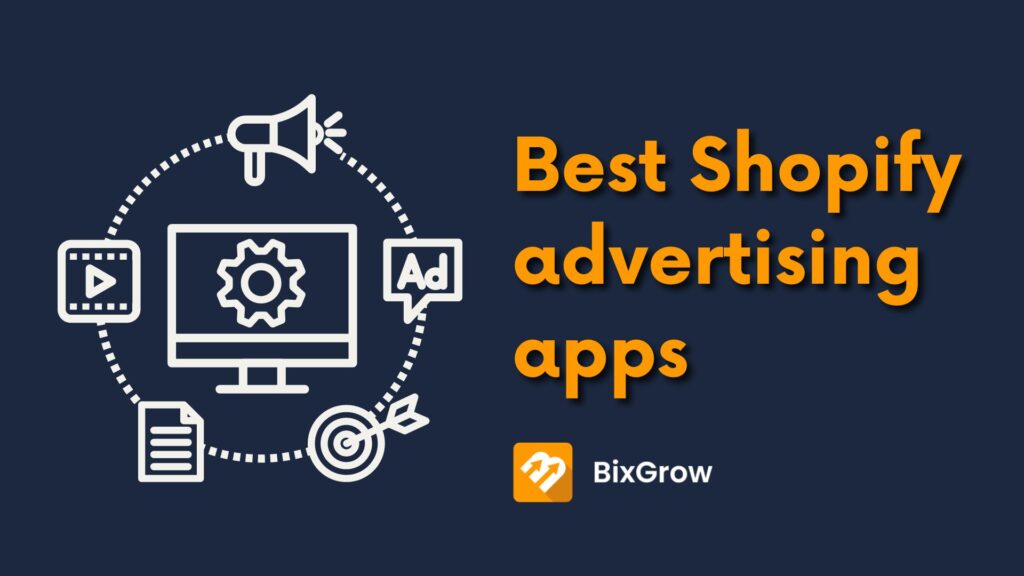
Strategies to Advertise Your Shopify Store
There are nearly dozen ways to advertise your store, including:
- Social media presence: Be a social butterfly! Build eye-catching profiles on Facebook, Instagram, or TikTok. Share product images, videos, behind-the-scenes moments, and helpful content for your niche. Visit Shopify social proof apps for more.
- Paid ads: Run targeted ads. Facebook and Instagram ads can handle grabbing attention. All you need is a smart ad plan aimed at your ideal audience.
- Influencer collaborations: Collaborate with influencers. Partnering with KOLs or KOCs who speak to your target market can boost sales and brand awareness at once.
- Email marketing: Use email marketing. Stay close to your audience by landing in their inbox.
- SEO optimization: Optimize for SEO. Improve your website’s organic traffic by researching keywords and using them in product titles, descriptions, and content.
- Content marketing: Try content marketing. Attract potential customers with informative blog posts, videos, or infographics.
- Affiliate marketing: Work with content creators & solo marketers to expand your brand reach.
You can visit the list of Shopify Advertising Apps for more categories.
9 Shopify Advertising Apps for store owners
1. Facebook & Instagram
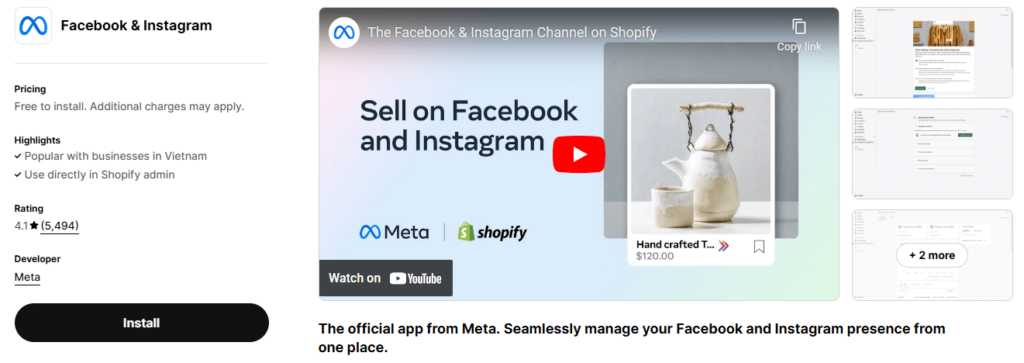
Facebook and Instagram Ads is offered by Meta, it allows you to set up and manage ads campaigns in both Facebook and Instagram within your Shopify store.
App Rate: 4.1 / 5.0 (over 5,449 reviews)
Key Features
- Ad Creation: It helps merchants create and launch ads in various formats (images, videos, carousels, etc.) to capture attention on Facebook and Instagram.
- Targeted ads: The app uses Facebook’s powerful demographic and interest-tracking capabilities to reach a highly targeted audience based on factors like age, location, interests, and online behavior.
- Performance tracking: Store owners can easily monitor the performance of their campaigns with detailed analytics, tracking metrics such as impressions, clicks, and conversions.
- Budget management: The app simplifies budget management, allowing users to set daily or lifetime budgets, ensuring cost-effective advertising.
- Integration with Shopify: It allows for product catalog syncing & merchants can promote their products with just a few clicks.
Pros
- It helps to reach millions of potential customers from Facebook & Instagram
- Provides insights into how ads are performing, helping merchants make informed decisions.
- Advanced audience segmentation based on user behavior and interests.
Cons
- Beginners may need to spend time learning how to optimize ads for maximum impact.
- Managing ad budgets effectively requires expertise to avoid overspending without generating enough ROI.
Facebook & Instagram Ads is a powerful tool for Shopify store owners. Its potential to reach a large, highly focused audience is readily apparent despite the learning curve. Examine your resources, target market, and advertising objectives carefully to see if this tool is a good fit for your store expansion plan.
2. TikTok
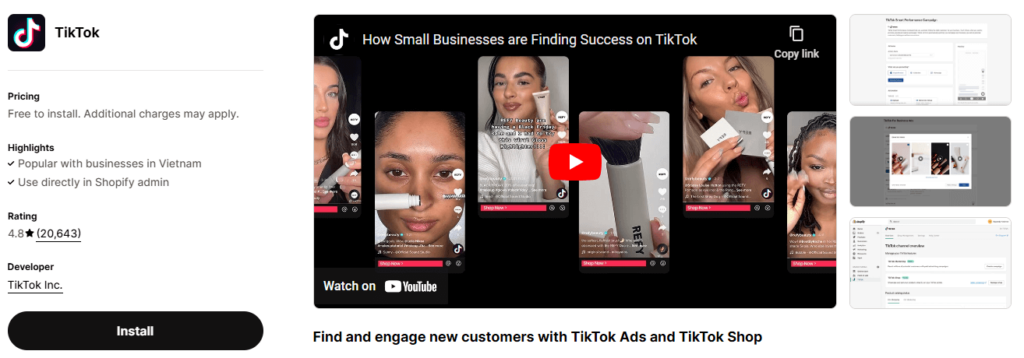
While people are familiar with Facebook and Instagram, Tiktok is also a potential social platform for owners to expand their business. It lets owners create short videos to showcase products and engage viewers at the same time. Currently, TikTok, with 1 billion of users, is among the most valuable Shopify apps for driving traffic.
App Rate: 4.8 / 5.0 (over 20,533 reviews)
Key Features
- Video Creation & Ads: Merchants can create short, eye-catching video ads directly within Shopify, showcasing their products to TikTok’s vast user base. The app offers easy-to-use templates to create content that fits TikTok’s style.
- Targeted reach: TikTok’s algorithm ensures that videos are shown to both followers and non-followers, increasing the reach and visibility of your products.
- Influencer collaboration: The app makes it simple to partner with TikTok influencers (KOLs or KOCs), leveraging their following to drive product awareness and boost sales.
- Organic and Paid Ads: You can promote your Shopify store through both organic content and paid TikTok ads, giving you flexibility in how you engage with your audience.
- Product links: While TikTok is testing new features like direct links to products, currently, users have to navigate to your Shopify store to make purchases, giving you the ability to drive traffic to your store.
- Analytics: TikTok provides performance metrics, helping you track video engagement, ad performance, and overall impact on sales.
Pros
- Tiktok is now testing on various links which can drive audiences to website, making it incredible competitive platform for marketing.
- TikTok attracts young demographics, helping natural
- Go viral is potentially with a single video makes it possible to increase traffic and sales
- User-generated content with a casual tone is highly rated to deeply connect with the audience
Cons
- Direct sale functions are limited and users need to actively navigate to your website to purchase
- Time-consuming to create content in short form and make it work
TikTok offers a unique opportunity for Shopify stores to connect with a younger, highly engaged audience. However, the lack of direct sales functionality and a maturing advertising landscape require a strategic approach. Consider your target audience and resources to determine if TikTok aligns with your overall marketing goals.
3. Google & YouTube
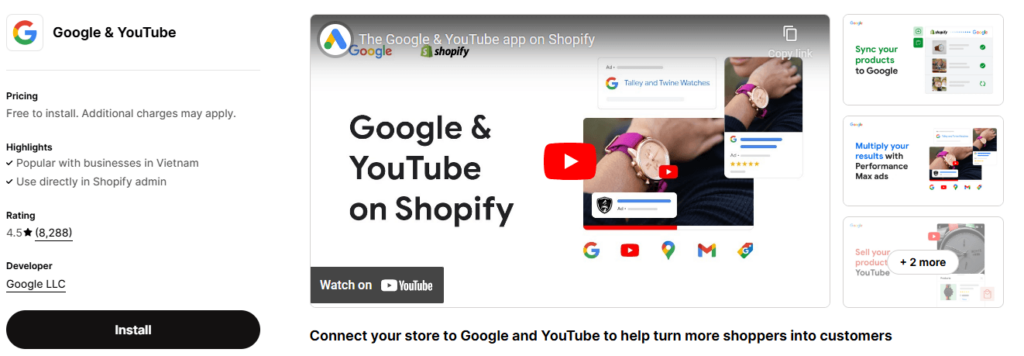
Besides social media platforms, advertising on website platforms is crucial to track as well. Google & YouTube make this happen with seamless integration into Shopify while tracking Google Search and Youtube Ads.
App Rate: 4.5 / 5.0 (over 8,268 reviews)
Key Features
- Google Search & Shopping Ads: You can create Google ads. This ads will appear in search results and Google Shopping, helping customers discover your products while using search engine.
- YouTube Video Ads: The app also allows store owners to create and manage video ads on YouTube, showcasing products through video content to engage and inform viewers.
- Product feed management: This integrates Shopify store with Google Merchant Center, allowing for automatic product syncing and management across Google platforms.
- Performance tracking & analytics: Merchants get detailed insights into their ads’ performance, including impressions, clicks, and conversions. This helps fine-tune campaigns to improve ROI.
- Campaign management: The app offers easy campaign setup and management, streamlining the entire process of advertising across Google and YouTube, all from your Shopify dashboard.
Pros
- Reach enormous user database of both Google and Youtube
- Storytelling digital content may leverage your brand’s video into new level
- Concise data and analytic reports make it effectively setting up advertising
Cons
- Campaign creation and management may be complex and takes time to master
- Budget requires careful consideration to not highly paid
- Wide competition landscape is challenging and requires high-volume effort
Google & YouTube Ads are powerful but require time and effort to master ads creation. But it can not deny Google & YouTube Ads’ ability to reach a massive audience pool with insightful video. Make sure to consider your resources and budget carefully.
4. BixGrow Affiliate Marketing
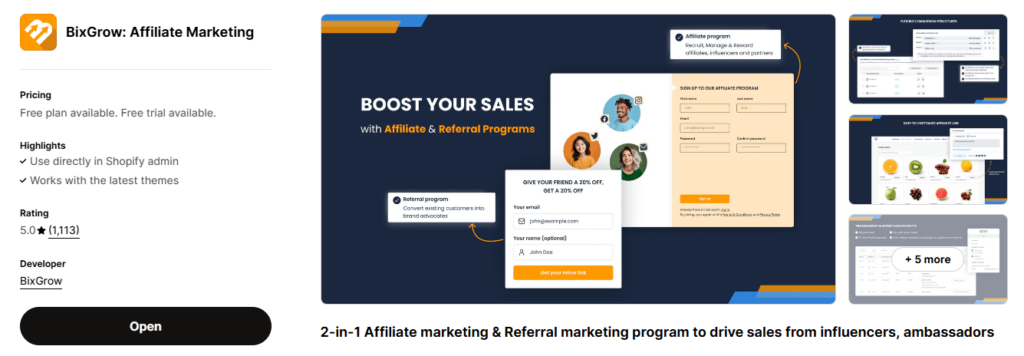
BixGrow Affiliate Marketing is a potential solution for those who are looking to expand Shopify’s reach and sales. Using this tool allows you to work with affiliate programs and nurture relationships with loyal customers to motivate them to promote your products for a commission.
App rate: 5.0 / 5.0 (over 1,110 reviews)
Key Features
- Affiliate commission structure: The app allows you to set up your affiliate marketing program effortlessly, defining rules, commissions, and payment methods (PayPal, Google Pay).
- Affiliate recruitment: You can create customizable affiliate recruitment forms, allowing you to recruit affiliates that fit your brand and goals.
- Affiliate performance tracking: Store owners can monitor the performance of individual affiliates and their sales contributions through detailed performance reports and dashboards.
- Payout flexibility: The app provides a flexible payout system, allowing merchants to pay affiliates automatically once they meet certain conditions.
- Discount codes & links: Merchants can offer their affiliates discount codes and unique referral links, making it easier to track performance and provide incentives for their audience.
Pros
- Best prices ($15 for full features access) amongst affiliate programs apps on Shopify.
- Expose products to a wide range of users to increase brand awareness and drive traffic
- Promote products with rewards to boost both sales and conversion
- Only pay for affiliate when it generates sales
- Both track and gain customer insight at the same time to make the campaign effectively
Cons
- Commitment time may be high to successfully build, manage, and monitor quality program
- Ability to find high-quality affiliate programs may take time and its result may be unsatisfied
- Unauthorized or fraud discount detection to protect your account is not included
BixGrow Affiliate Marketing is a user-friendly platform for Shopify owners, even the newbie level can easily establish an affiliate program. However, beginners may be aware to invest time in managing programs, recruiting, and monitoring.
5. Pinterest
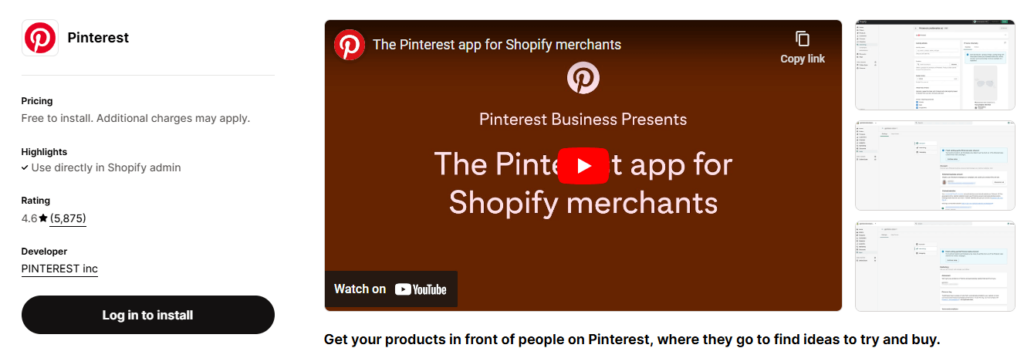
Pinterest offers a unique approach to advertising via creating pins – visually rich content that links directly to your product pages.
App Rate: 4.6 / 5.0 (over 5,873 reviews)
Key Features
- Visual-based marketing strategy showcasing eye-catching product images
- Target audience who interact with your post or similar to yours
- High-quality visuals can attract organic traction
- Shop directly in pins (may be developed in July 2024)
Pros
- Pinterest’s users are those who actively and continuously seek aesthetic new product images
- Pinterest stands out among other social media platforms when providing Pin to showcase products
Cons
- Users navigate from Pin themselves, not automation
- The store has high-visual images that seem to distribute better
- There is no direct integration between Shopify and Pinterest Ads at the moment
Pinterest Ads is a unique support for Shopify stores to reach a high amount of users although it has indirect navigate progress. Carefully weigh out its pros and cons to decide whether to apply it for your store or not.
6. Simprosys Google Shopping Feed
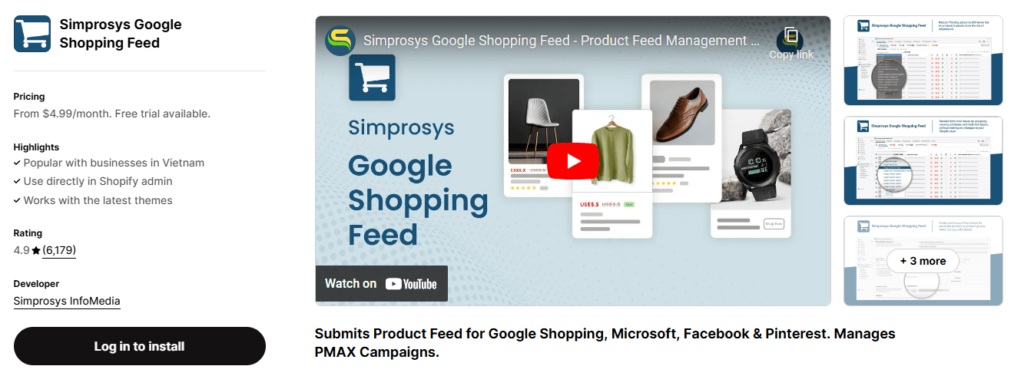
Simprosys Google Shopping Feed can simplify your product showcase steps on Google Shopping. Using this can ensure your product information is concise, up-to-date and optimized.
App Rate: 4.9 / 5.0 (over 6,172 reviews)
Key Features
- Simple feed management, saves time in uploading to Google Merchant
- Product data optimized with category mapping and custom attributes
- Get insight directly from product listings on Google Shopping to improve area
Pros
- Feed can automatically be created to save manual set-up time
- Accuracy of product data from errors to inconsistencies highly minimized
- Make performance better using key metrics tracking
Cons
- Monthly subscription fee and learning curve required
- Complex features available in the advanced plan
Simprosys Google Shopping Feed maximizes product optimization on Google Shopping. Functions such as automatic feed management, updates, and data tracking are powerful.
7. AI SEO Optimizer & SEO Booster
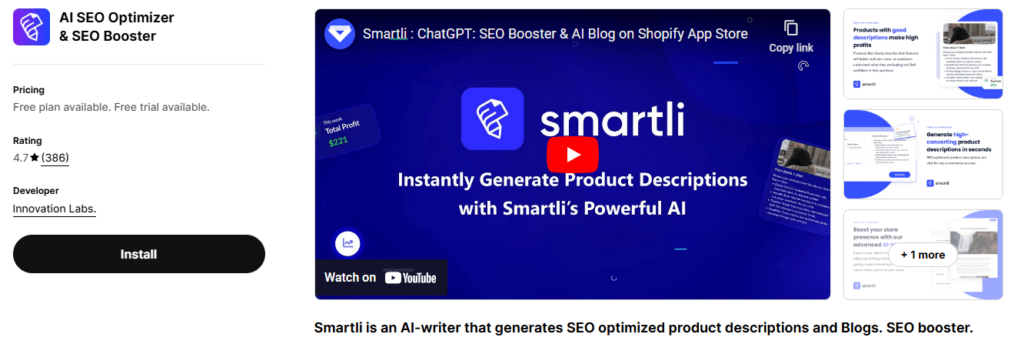
While not a direct Shopify app, ChatGPT has emerged as a popular tool for content creation and SEO optimization. This AI-powered platform can assist you in various tasks, but it’s important to understand its strengths and limitations before diving in.
Check out AI SEO Optimizer & SEO Booster
App Rate: 4.7 / 5.0 (over 380 reviews)
Key Features:
- Brainstorm all kinds of content such as product names, product descriptions, blogs for content block reduction
- Generate insightful keyword for search engine optimization
- Suggest various content formats and improve them according to user’s demand
Pros
- AI-power helps improve content creation flow
- Keyword with valuable insight is AI-generated
- Content quality is improved within a few minutes
- Ability to generate various content formats and ideas from scratch
Cons
- Important to check facts after the AI generation
- Information is not up to date and accessible at this present time
- Generate ideas only, not eliminate human thinking demand for content
ChatGPT assists Shopify owners in the content creation journey, especially SEO. However, ChatGPT is an AI supporter, not 100% humanized. Remember to input effort for concise outputs for a better marketing strategy. Most of SEO apps are now using A.I.
8. AfterShip Feed for TikTok Shop
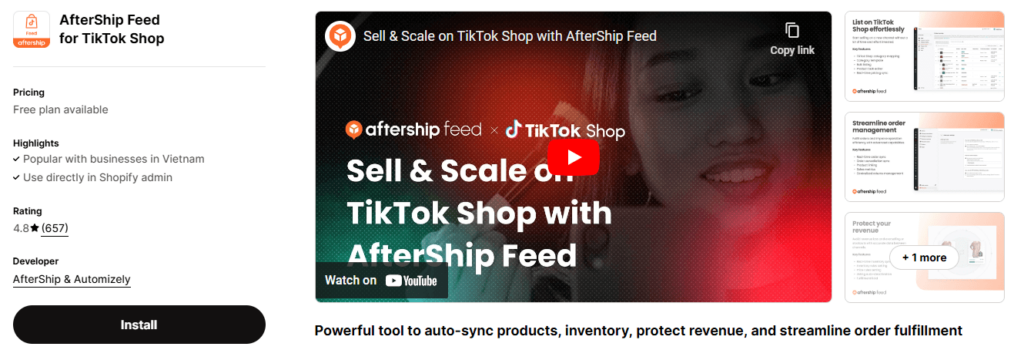
AfterShip Feed saves time for Shopify owners when seamlessly integrating Tiktok Shop, simply listing products, managing inventory, and fulfilling orders.
App Rate: 4.8 / 5.0 (over 655 reviews)
Key Features
- Automatically sync Shopify products with Tiktok Shop, update inventory, change price, fulfill order
- Maintain products in the correct product category
- Able to edit in bulk
- Fraud transaction minimization to protect revenue status
Pros
- Setup and manage with little effort
- Inventory status remains accurate across platforms
- Increase product discoverability with category mapping
- Order process with fraud prevention
Cons
- AfterShip Feed requires a monthly subscription fee
- New features are limited for some users
Suppose you’re a Shopify store owner looking to expand your reach to TikTok Shop. In that case, AfterShip Feed is a powerful solution when effectively listing the products, managing inventory, and fulfilling orders for you to save time, grow your brand, and engage the audience.
9. PixelPro for TikTok Pixel
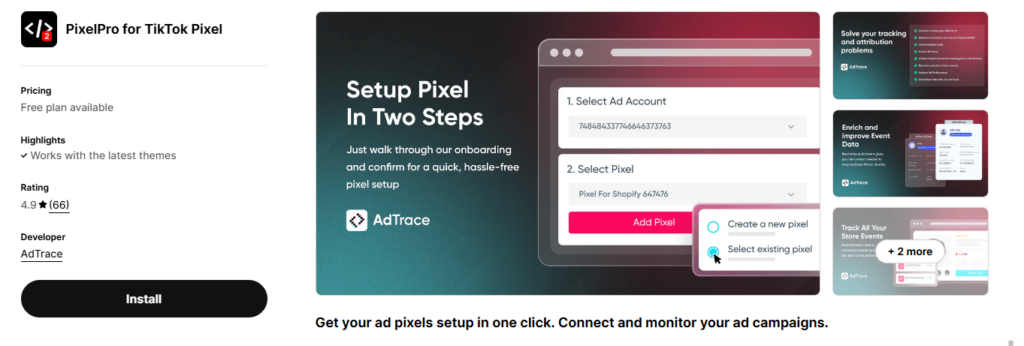
PixelPro for TikTok Pixel is well-optimized when it comes to the installation of the TikTok Pixel on your Shopify store. This pixel serves as a connector that allows you to monitor the effectiveness of your TikTok ads and c/web traffic driven by them.
App Rate: 4.9 / 5.0 (over 66 reviews)
Key Features
- Install pixel within simple steps in the Shopify store
- Easy to track ads performance and traffic
Pros
- Effectively gain insight data for enhancing ads performance
- Manual code is not required, which makes data simple to collect
Cons
- PixelTok offers Tiktok Pixel only, not effective ads creation, management, and analyzation
- PixelTok collects data with simple methods, to gather deeper analysis, additional tools are required
- PixelTok is a basic version of Tiktok Ads and can not replace Tiktok Ads
PixelTok has a simple theme and is beginner-friendly. It simplifies the installation on Shopify stores. Data for campaigns is easy to collect too. However, PixelTok is a foundation tool. You need to self-learn to set up comprehensive ads.
Conclusion
To decide which advertising app is the best for your store, it depends on your marketing strategy and performance goal. You can try to integrate multiple apps for a cohesive advertising strategy for multiple channels. Choosing the right Shopify advertising tools can be the first step for your store’s success as it helps reach a wide range of target audiences, sales-driving, and store growth at the same time.